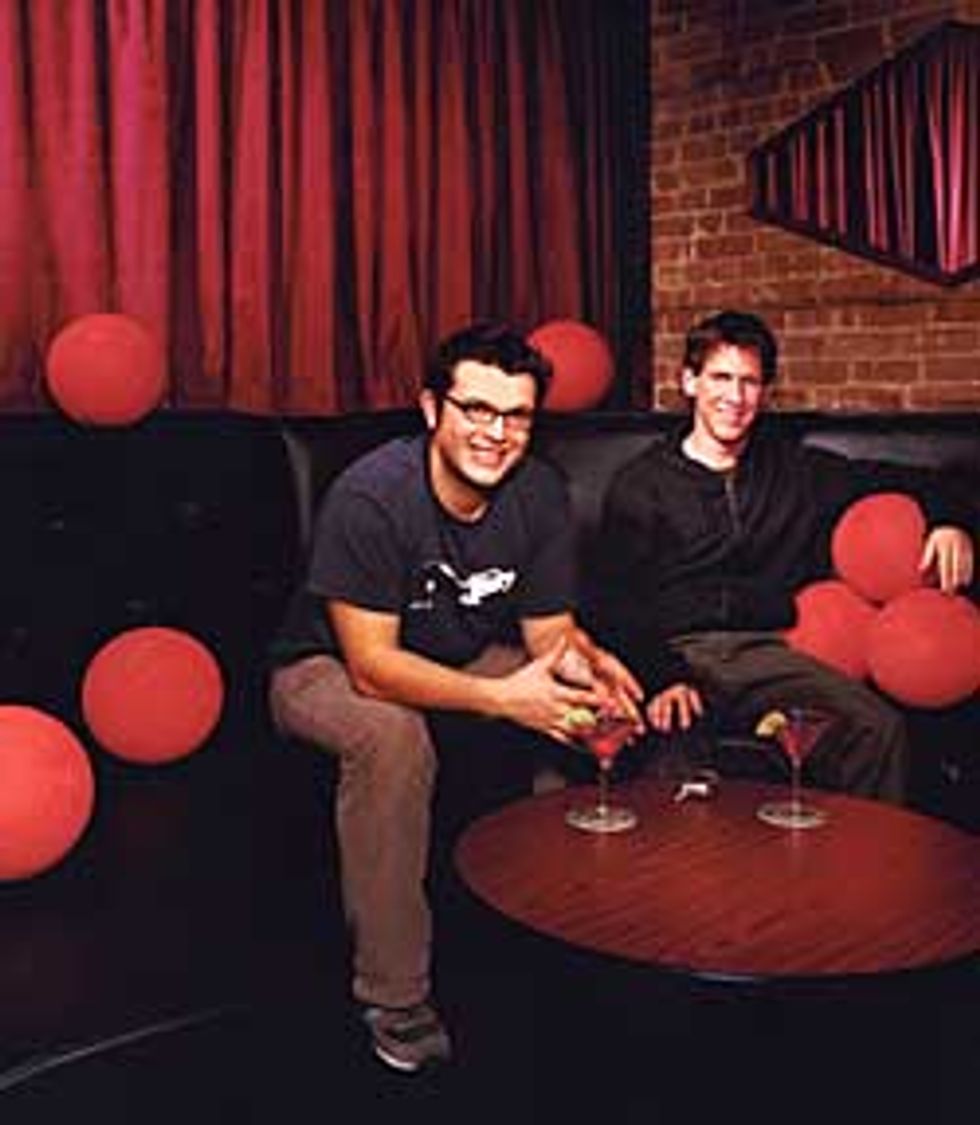When Dennis Crowley was a student two years ago at New York University's Interactive Telecommunications Program, his social life was so active that he couldn't keep track of all the friends he wanted to hang out with. So he patched together a computer program to allow him to send cellphone text messages to all his friends at once. "It was faster to do that than to talk on the phone," says Crowley.
Dodgeball.com founders Dennis Crowley [left] and Alex Rainert created a location-based social networking tool that allows urbanites to link up while out on the town.
But he soon realized that sending a message to each and every one of his friends—including those who were holed up in the library or out of the state visiting their parents—didn't make much sense. So he worked out a way to send a message that would be received only by friends within 10 blocks of wherever he was at the moment (more on that later). Then the Friendster.com craze hit in early 2003, in which individuals using the Web site set up by Friendster Inc., Mountain View, Calif., could join up with friends and friends of friends to form sprawling social networks. Following suit, Crowley teamed up with Alex Rainert, a fellow NYU graduate, and added a similar Web-based interface to his text messaging program.
The result—a mobile social networking tool called Dodgeball—allows young urbanites to link up and meet face to face when they're out on the town. Today it boasts 15 000 users in 22 U.S. cities.
Joining Dodgeball means filling out a profile, posting photographs of yourself on the Dodgeball Web site (https://www.dodgeball.com), and listing your friends and their cellphone numbers.
"It's become a natural part of going out," says Kristin E., a 24-year-old print broker living in New York City. "It's the easiest way to let people know where I am."
When Kristin goes to one of her favorite bars, Local 138, and wants some company, for instance, she sends a text message to nyc@dodgeball.com with the text "@ Local 138."
From Kristin's point of view, a few things happen. First, a message goes out to all her friends nearby letting them know where she is. Then, she may get a message telling her the location of a nearby friend of a friend. Next, Kristin may or may not get a message letting her know that somebody she has identified in her online profile as a "crush"—someone she is anxious to meet—is nearby (the system will also notify her should somebody with a crush on her be close by). If the tool fulfills its purpose, the evening will include Dodgeball-facilitated serendipitous encounters—with friends, friends of friends, or crushes.
Behind the scenes, there's a lot more going on. When Kristin checks in from Local 138, Dodgeball has to do a number of things. First, it looks at which in-box her message landed in (nyc@dodgeball.com, sf@dodgeball.com, and so on) to figure out which city she's in. Next, Dodgeball looks at the originating e-mail address, ensuring that the message came from a mobile device, and looks up Kristin's profile.
The next step is to look up the venue's latitude and longitude in a database. Each bar or coffee shop in Dodgeball's database is geo-coded, which means its address has been converted into Global Positioning System coordinates by the service's founders. For New York City, the database includes many of the city's most popular spots—such as restaurants, museums, theaters, and sports arenas. Dodgeball then sends messages to all of Kristin's friends who are nearby, letting them know where she is.
Next comes the friend-of-a-friend function. Dodgeball finds other users who have checked in within the last 3 hours and compares their locations on a virtual map to see if any are within 0.8 kilometers (10 city blocks) of Kristin. Dodgeball looks through the social network, finding friends of Kristin's friends. To keep from bombarding users with constant messages, it selects the closest one (Steve, let's say)—and both get messages. Hers would state: "Steve @ The Magician. You know Steve through Jay," while his would read: "Kristin @ Local 138. You know Kristin through Jay."
Finally, acting as a sort of low-level dating service, Dodgeball checks the crush list and sends crush messages if applicable.
Whether Dodgeball succeeds as a business may depend on its success as a social platform. "With Dodgeball, you know there's always someone out there you can run into," says Kristin. "It makes the city feel smaller, more homey." How much users like her will pay to send and receive Dodgeball messages remains to be seen. The service is currently free, but Crowley would like to start charging for the Dodgeball messages.
"Whenever a popular new technology has appeared, from piano rolls to VCRs, people have always questioned its viability—because it doesn't look like the old model—but in the end, we've always found a way to pay for the things people like doing," says Clay Shirky, an adjunct professor in NYU's Interactive Telecommunications Program. "So if people keep finding value in it, it will be viable as a business."
Now that Crowley's title has gone from "grad student" to Dodgeball's founder, he's counting on it. "It's all about how we can make this into our full-time jobs," he says. "Technology is easy. Business is difficult."
Jay Dixit is a technology writer based in New York City. His work has appeared in The New York Times, the Washington Post, Rolling Stone, and the Village Voice.
